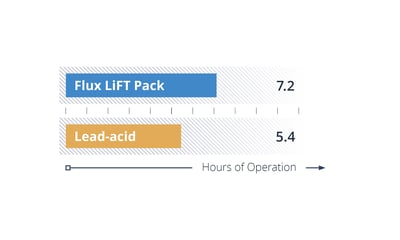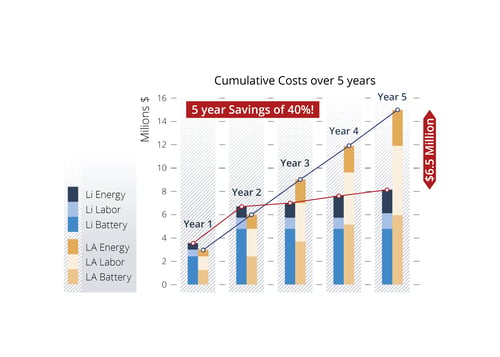Purchasing a forklift battery is an important investment. The question for many companies, however, is whether their choice is a good investment.
The average cost of a lithium-ion battery is between $3,000 and $20,000, depending on battery size. This price tag can be up to twice as much as the average purchase price of a lead-acid battery. However, when you factor in the long-term costs, a lithium-ion battery is less expensive than a lead-acid battery.
Lithium-ion batteries offer significantly more benefits that make them a better long-term investment for most companies. Here’s why.
A Longer Lifespan
One of the first attributes a manager looks at is the average lifespan of a battery type.
A battery with a longer lifespan generally makes it a more valuable investment. If employees properly maintain the batteries in their fleet, the average lifespan of a lithium-ion battery is between 2,000 and 3,000 cycles.
A lithium-ion battery’s lifespan is twice as long as the average lifespan of a lead-acid battery, which is between 1,000 and 1,500 cycles.
Batteries with shorter lifespans need to be replaced more often, and you may need at least two lead-acid batteries to last the lifespan of one lithium-ion battery.
Longer Run Times
How long a battery runs before it must be charged impacts productivity and the overall efficiency of an operation.

Lithium-ion batteries typically run about 7.2 hours before requiring a charge. And, they can be safely discharged down to 20% capacity.Lead-acid batteries, on the other hand, require charging after about 5.4 hours of use. And, they can only be safely discharged down to 30% capacity.
The longer a battery is in service, the more cost-efficient it is to an operation. Swapping batteries after just 5.4 hours of use can lead to costly downtime for employees who must then remove the batteries from equipment and replace them with charged batteries so equipment can go back into service. This takes away productive time.
Shorter Charging Times
Lithium-ion batteries take just 1 to 2 hours to charge. They can be opportunity charged in between shifts or while employees are on break. Because of this, only one lithium-ion battery is typically needed per piece of equipment, regardless of how many shifts a company works.
Lead-acid batteries require 8 hours to charge and another 8 hours to cool down. This means that the true amount of time needed for a lead-acid battery to charge and go back into service is closer to 16 hours.
This is key for companies that have multi-shift operations. If a warehouse operates 24 hours a day, equipment that is powered by lithium-ion batteries can be opportunity charged a few times throughout the day. That means one lithium-ion battery can be used for the entire duration of the 24-hour period as long as it has been charged.
If using lead-acid batteries to power equipment over the course of 24 hours, one piece of equipment would require three lead-acid batteries since workers would need to completely replace the battery after approximately 5 to 6 hours of use and then charge and cool it for 16 hours.
In other words, managers must purchase three lead-acid batteries for each piece of equipment to cover a 24-hour period.
Saved Labor Costs
Labor costs are key to determining the true cost of a battery. As mentioned above, lithium-ion batteries can be opportunity charged quickly and efficiently. The process of charging a lithium-ion battery can also save a company substantially in labor costs.
That’s because of lithium-ion batteries:
- Remain in the equipment during charging
- Do not require transport to a separate charging space
- Do not require extra time to refill the battery with an electrolyte solution
In contrast, when charging a lead-acid battery:
- An operator must use special lifting equipment and because of the battery’s weight, trained personnel must then remove the battery and place it on a storage rack where the charging will be done
- The battery is then charged for approximately 8 hours.
- Once the charging process is completed, the cooling down stage begins. This lasts an additional 8 hours.
- The battery will either remain where it was charged or personnel may transport it to a designated cooling area if space is needed in the battery room to charge other batteries.
In fact, one major equipment manufacturer discovered it could save over $1 million by switching to lithium-ion batteries, simply due to the amount of lost productivity per day associated with charging the lead-acid batteries they were using to power their fleet of equipment.
Safer For Employees
A safer work environment is one of the best investments a company can make. Lithium-ion battery technology offers several enhanced safety features:
- They do not require water maintenance. Lithium-ion batteries are sealed shut, whereas lead-acid batteries are filled with an electrolyte solution. They require regular refilling with water or the chemical process will degrade and the battery could suffer an early failure. Watering a battery comes with risks. If a spill occurs, highly-toxic sulfuric acid can splash onto the body and cause serious injury.
- There is minimal risk of overheating. Lithium-ion batteries have a battery management system that tracks cell temperatures to ensure they remain in safe operating ranges. If lead-acid batteries overcharge, the electrolyte solution can overheat, increasing pressure inside the battery. This can damage the battery, or worse, cause an explosion.
- Less movement of the battery reduces the risk of injuries. Because lithium-ion batteries can stay inside the forklift for the charging process, workers avoid any risks associated with battery swapping. Batteries can weigh several thousand pounds, and lead-acid batteries require material handling equipment to lift and swap the batteries for charging.
You can read more about how using lithium-ion batteries can improve the overall safety of your operations in our article, The Top 5 Ways A Lithium-Ion Battery Makes Your Forklift Safer.
A Good Investment For The Future
Often, an option that has a low upfront cost can be the most costly choice in the long run, which is why it is important to know what you are buying.
A lithium-ion battery is a smart investment because it not only lasts longer, improves productivity and saves costs, it also enhances safety … protecting your most important investment … your employees.
Our article, How To Choose The Right Forklift Battery, offers a more detailed look into the cost of ownership based on a five-year period.
About the Author:
Justin Forbes is the Director of Business Development at Flux Power. He graduated with a degree in Mechanical Engineering from UC San Diego and earned his MBA from Duke University. He is responsible for developing marketing and customer acquisition initiatives, along with creating new business growth strategies to increase sales.











